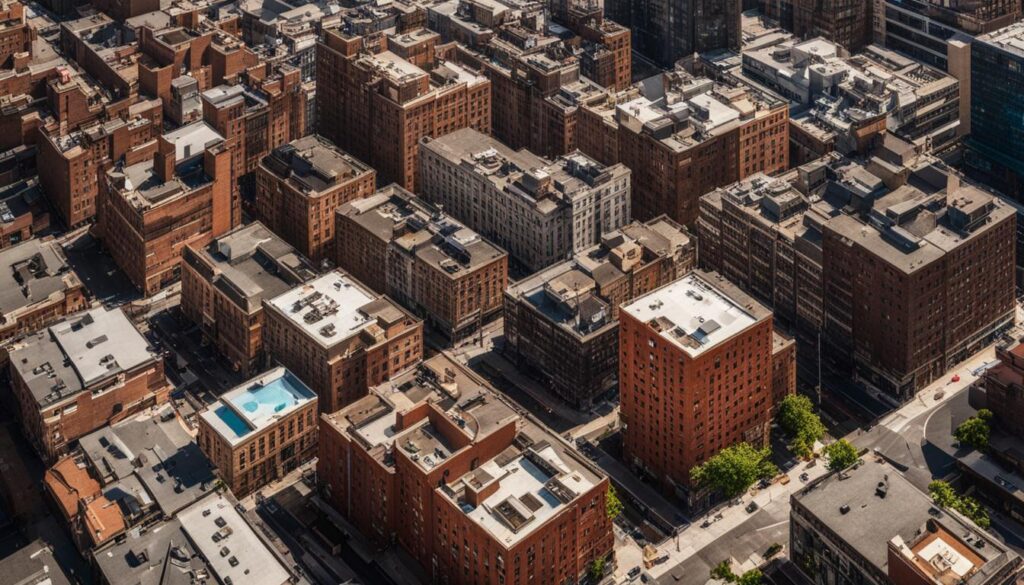If you’re involved in construction projects in Victoria, you need to be familiar with the Victorian Building Code. This set of regulations is designed to ensure the safety, quality, and legal compliance of construction projects throughout the state.
However, the code can be complex and challenging to navigate for those unfamiliar with its requirements. That’s why we’ve created this guide to help you understand the Victorian Building Code and its importance in construction projects in Victoria, Australia.
Key Takeaways
- The Victorian Building Code is a set of regulations designed to ensure the safety, quality, and legal compliance of construction projects in Victoria.
- Compliance with the code is essential to avoid legal issues and ensure the safety of construction projects.
- Understanding the code’s requirements and obtaining the necessary permits is crucial for compliance.
- Staying up-to-date with changes to the code is essential for ensuring ongoing compliance with industry standards and practices.
- By following the Victorian Building Code, you can ensure the safety, quality, and legal compliance of your construction projects in line with Victorian regulations.
Understanding the Victorian Building Code
As we mentioned in the previous section, the Victorian Building Code is the primary set of regulations that governs all construction projects in Victoria. The code was established to ensure the safety, health, and welfare of the public and to set minimum standards for the design and construction of buildings across the state.
The Victorian Building Code consists of a set of guidelines and requirements that cover many aspects of construction projects, including but not limited to:
- Building standards and construction materials
- Structural design and integrity
- Safety and accessibility
- Fire safety measures
- Energy efficiency and sustainability
Adhering to the Building Code regulations is essential to ensure that the construction project meets the designated construction and safety standards.
Understanding the Victorian Building Code can be complicated due to the various regulations and requirements, which can change over time. All construction industry professionals in Victoria must have an in-depth knowledge of the Victorian Building Code to ensure their projects are up to code and compliant with the regulations.
Tip: If you’re unsure about any aspect of the Victorian Building Code, consider consulting a building code professional or conduct additional research to ensure you comply with the regulations.
Compliance and Permits
Ensuring Building Code compliance is a vital component of construction projects in Victoria. Failing to comply with the regulations can lead to legal issues, safety concerns, and impacts on the overall quality of the project. That’s why we’re here to guide you through the essential steps and requirements of complying with the Victorian Building Code so that you can avoid potential pitfalls and adhere to the relevant Victorian building permits.
Steps for Building Code Compliance
The primary step for Building Code Compliance in Victoria is to obtain a building permit to ensure that your construction project meets the required standards. Building permits can be obtained through the relevant local council or private building surveyor. The building surveyor will regulate your project and undertake inspections throughout the construction process, ensuring you are meeting the required standards for compliance.
Documentation and Approvals
When it comes to Building Code Compliance, proper documentation and approvals are essential. You will need to submit detailed documentation illustrating your plans and specifications to make sure that you meet the required construction and safety standards. The local council or private building surveyor will determine if your project is up to par, granting you necessary approvals or requesting additional documentation.
If you are undertaking a large construction project, you may also need to obtain planning permits from the relevant authorities, ensuring your project aligns with zoning and land use regulations. Additionally, you must adhere to environmental standards, including wastewater disposal and pollution control regulations.
Building Code Compliance Inspections
During the construction process, building surveyors perform inspections to ensure compliance with the Building Code regulations. Regular inspections are carried out to monitor the construction, covering all the crucial stages of the project, including the foundation, frame, and waterproofing. Once the project is completed, a final inspection will take place to ensure all standards have been met.
Remember, compliance with the Victorian Building Code is not only essential for meeting legal requirements, but it also guarantees the safety of the public and the quality of construction projects. By complying with regulations and obtaining the necessary building permits, you can ensure that your construction project adheres to local building codes and regulations.

Understanding Building Code Requirements
Complying with the Building Code requirements is essential for ensuring the safety and quality of your construction project, in line with the Victorian construction regulations. These requirements are periodically updated to keep up with emerging industry trends, meaning it’s important to stay informed about any new changes.
To help you navigate the requirements, we’ve broken them down into the key areas you need to know:
| Area | Key Requirements |
|---|---|
| Building Structure |
|
| Fire Protection |
|
| Plumbing and Drainage |
|
Additionally, it’s important to understand that the Building Code requirements vary based on the classification of the building. For example, a residential property may have different requirements compared to a commercial property. Familiarizing yourself with the specific requirements for your building classification can help ensure compliance with the Building Code.
Staying up to date with the Building Code requirements is crucial for ensuring your construction project meets the necessary standards set by the Victorian construction regulations. By keeping yourself informed and adhering to the key requirements, you can ensure the safety and quality of your construction project and avoid any legal repercussions.
Building Code Standards
Building code standards are established to ensure buildings are structurally sound, safe for occupants and meet particular design requirements.
There are several standards set by the Victorian Building Code that cover various aspects of construction, including:
- Structural Standards: These cover the minimum requirements for the design, construction, and materials used in building structures.
- Fire Safety Standards: These cover the requirements for the construction and materials used in buildings to reduce the risk of fire and ensure the safety of occupants.
- Plumbing Standards: These cover the design and installation of water supply, drainage, and sanitation systems in buildings.
- Electrical Standards: These cover the requirements for the design, installation, and maintenance of electrical systems in buildings.
- Access Standards: These cover the requirements for accessibility and mobility within buildings for people with disabilities or limited mobility.
The Victorian Building Code sets a high standard for construction in Victoria, and it’s important to follow these standards to avoid legal issues and ensure the safety and quality of buildings.
Here is an example of how Building Code standards can impact building design:

Example:
| Building Feature | Building Code Standard | Impact on Design |
|---|---|---|
| Maximum Floor Area | The maximum floor area for a residential building is 500 square metres. | The maximum size of the residential building must not exceed 500 square metres. This will affect the layout and design of the building to ensure it is within the allowed size limit. |
| Fire Safety Requirements | Fire-resistant materials must be used in the building’s construction. | The building must use fire-resistant materials such as fire-rated plasterboard and insulation. This will affect the choice of construction materials and the overall design of the building. |
| Accessibility Standards | Access in and out of the building must be provided for people with disabilities or limited mobility. | The building must include ramps, lifts and other features to allow people with disabilities or limited mobility to access the building. This will affect the design and layout of the building to ensure it is accessible to all people. |
Understanding the Building Code standards is crucial for ensuring compliant building design and construction. By following the standards set by the Victorian Building Code, building owners can ensure the safety and quality of their projects.
Key Considerations for Building Code Compliance
Ensuring Building Code compliance is vital for any construction project in Victoria, Australia. Failure to comply with the Victorian Building Code can result in legal issues, penalties, and even costly delays.
Here are some key considerations to keep in mind when striving for Building Code compliance:
1. Understand the Code’s Requirements
The Victorian Building Code has several requirements that construction projects must follow. It is essential to understand these requirements before commencing any work.
From structural integrity to fire safety measures, there are many areas to consider. Engage the services of a Building Code consultant or inspector to ensure your project conforms to the regulations.
2. Have a Plan in Place
Before starting any construction project, it’s essential to have a comprehensive plan in place. This plan should include details such as building materials, structural specifications, and permits required for the project.
The Building Code consultant or inspector can aid in developing a suitable plan that meets the specific requirements of the Victorian Building Code.
3. Work with Professional Contractors
Working with professional contractors who have a good understanding of the Victorian Building Code can be extremely beneficial. These contractors can guide you through the compliance process and help ensure your construction project meets all the necessary requirements.
4. Keep Up-to-Date with the Building Code Requirements
The Victorian Building Code’s requirements are continually updated to reflect changes in the industry and best practices. Therefore, it is vital to stay up-to-date with these changes and adjust the construction approach accordingly.
Subscribe to industry publications, attend seminars, and consult with Building Code consultants to stay informed and ensure your project meets the latest requirements.
Failure to comply with the Victorian Building Code can have far-reaching consequences. It is essential to take the necessary steps to ensure full compliance and protect your construction project’s integrity.
Navigating the Permitting Process
The process of obtaining Victorian building permits can be intricate and time-consuming. We recognize the importance of securing the necessary documentation and approvals required to start construction.
The permit application process involves several steps, including the submission of detailed plans and documentation to the relevant regulatory authorities. It’s vital to ensure that your documentation complies with Building Code regulation standards before submission.
Here is a step-by-step guide to navigating the permitting process:
- Start by identifying the type of Victorian building permit you need. Check the government websites to see the various permit types, such as building, demolition, and occupancy permits.
- Complete the relevant application forms, providing accurate and detailed information. Ensure that your plans reflect compliance with the Building Code regulations.
- Submit the application forms and supporting documentation through the online portal or in-person to your local council office.
- Wait for your application to be reviewed and assessed by the relevant authorities. It can take several weeks or months for approval depending on the complexity of your project.
- If your application is successful, the local council will issue the permit with the relevant Building Code regulations attached. If it’s not successful, you will receive a written notice detailing the reasons for the rejection and further actions required.
Remember, building permits are mandatory in Victoria, and non-compliance can result in penalties and legal consequences. Therefore, it’s essential to ensure that you have secured all the necessary permits before commencing with any construction work.

Staying Up to Date with Building Code Changes
At Victorian Building Authority, we understand that keeping up with Building Code regulations can be overwhelming, especially with the frequent updates that occur based on industry changes. However, it is essential to stay current with the latest regulations to ensure compliance and avoid legal repercussions.
One of the best ways to stay updated on Victorian Building Code changes is by regularly checking our website, as we provide daily updates on any new regulations and standards. Additionally, we provide resources, such as podcasts and webinars, to help builders stay informed.
Another excellent resource is the Building Code of Australia website, which provides access to state and territory building regulations, including Victorian Building Code regulations.
By staying informed about Building Code changes, you can ensure that your construction projects comply with all relevant standards and regulations. It ultimately helps to create a safer and higher quality built environment, benefiting both builders and the community as a whole.
Conclusion
In conclusion, navigating the Victorian Building Code is vital for anyone involved in construction projects in Victoria. Understanding the code, complying with its requirements, and obtaining the necessary permits are essential steps to ensure the safety, quality, and legal compliance of your construction projects in line with Victorian regulations.
At every stage of the process, it is important to be aware of the relevant regulations and standards and to keep up to date with any changes that may affect your project. By doing so, you can avoid costly legal disputes, delays, and potential safety hazards.
We hope that this guide has provided you with a comprehensive understanding of the Victorian Building Code and its importance in construction projects in Victoria. If you have any further questions or concerns, do not hesitate to seek professional advice from a qualified building surveyor or consultant.
FAQ
What is the Victorian Building Code?
The Victorian Building Code is a set of regulations and guidelines that govern the design, construction, and safety standards for buildings in Victoria, Australia. It ensures that buildings are structurally sound, comply with fire safety regulations, and promote accessibility and sustainability.
Why is it important to comply with the Victorian Building Code?
Compliance with the Victorian Building Code is crucial to ensure the safety, quality, and legal compliance of construction projects. It helps protect people’s lives and property by establishing minimum standards for structural integrity, fire safety, and accessibility. Non-compliance can result in penalties, fines, and legal consequences.
How do I ensure compliance with the Victorian Building Code?
To ensure compliance, it is important to familiarize yourself with the specific requirements of the code, engage qualified professionals, such as architects and engineers, who are knowledgeable about the code, and obtain the necessary permits and approvals. Regular inspections and adherence to construction standards are also essential.
How do I obtain building permits in Victoria?
To obtain building permits in Victoria, you need to submit a complete application to the relevant local council or building surveyor. The application should include detailed plans and specifications of the proposed construction, along with other required documentation. The permit will be issued once the application is reviewed and approved.
What are some key requirements of the Victorian Building Code?
The Victorian Building Code specifies requirements related to design, structural stability, fire safety, plumbing, energy efficiency, accessibility, and more. It covers aspects such as building materials, construction techniques, and mandatory inspections to ensure compliance with industry standards and achieve safe and sustainable buildings.
Where can I find resources to stay updated on building code changes?
To stay informed about building code changes in Victoria, you can visit the website of the Victorian Building Authority or subscribe to their newsletter. You can also consult industry publications, attend seminars or workshops, or seek guidance from professionals in the construction industry who are well-versed in the current building regulations.
